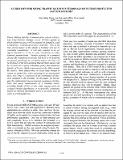Guidelines for sizing traffic queues in terminals of future protected satcom systems
Author(s)
Wysocarski, Jeffrey S.; Sun, Jun; Wang, Mu-Cheng
DownloadWang-2009-Guidelines for sizing traffic queues in terminals of future protected satcom systems.pdf (5.865Mb)
PUBLISHER_POLICY
Publisher Policy
Article is made available in accordance with the publisher's policy and may be subject to US copyright law. Please refer to the publisher's site for terms of use.
Terms of use
Metadata
Show full item recordAbstract
Future military satellite communication systems will feature time-division multiple access (TDMA) uplinks in which uplink resources will be granted on demand to each terminal by a centralized resource controller. Due to the time-shared nature of the uplink, a terminal will not be constantly transmitting. It will only transmit in its assigned timeslots so as not to cause interference to other terminal transmissions. Packets arriving at a terminal during idle transmission periods will have to be buffered or queued, potentially in a terminal router, else they will be dropped. At the next assigned timeslot these queues will be serviced via a queue scheduling policy that maintains quality-of-service (QoS) requirements to the different traffic classes. These queues must be sized large enough to ensure no packet loss when operating in an uncongested state; how large is a function of the distribution of timeslots assigned to the terminal. In this paper, we investigate the relationship between timeslot assignment distributions and queue requirements of a terminal router, providing insight of how to size router queues given an assigned timeslot distribution, or reciprocally, constraints placed on timeslot distribution given a set queue size, in order to avoid packet loss.
Date issued
2009-10Department
Lincoln LaboratoryJournal
IEEE Military Communications Conference
Publisher
Institute of Electrical and Electronics Engineers
Citation
Mu-Cheng Wang, Jun Sun, and J. Wysocarski. “Guidelines for sizing traffic queues in terminals of future protected satcom systems.” Military Communications Conference, 2009. MILCOM 2009. IEEE. 2009. 1-8. © 2009, IEEE
Version: Final published version
Other identifiers
INSPEC Accession Number: 11104269
ISBN
978-1-4244-5238-5